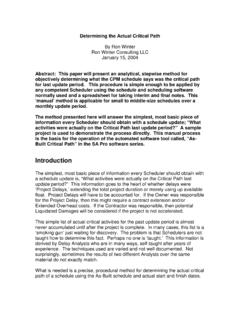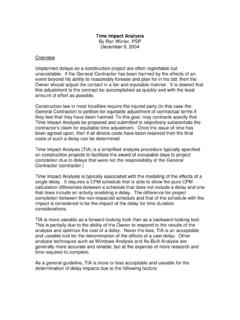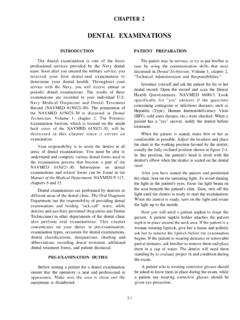Transcription of Living with P6 Databases - Ron Winter Consulting LLC
1 1 Living with P6 Databases By Ron Winter , PSP Copyright Ron Winter Consulting LLC 2012 July 16, 2012 2 Abstract A P6 Scheduler is required to know much more than just how to schedule; he or she must plan, maintain, and repair the database . The alternative is to trust that Primavera and their support staff have done this for you and knows what is best. This paper explains what a database Server is and what you need to know to keep your CPM scheduling platform up and running. It covers database types, checking the database size, backing-up your schedules and database , differences between Databases , creating a second database , and configuring a database . We will attempt to describe these issues and solutions for both Oracle Express as well as MS SQL Express Databases . People running the full-blown database servers ought to have trained IT personnel and their issues are not covered here.
2 Introduction Oracle/Primavera P6 software is a high-powered Critical Path Method (CPM) based scheduling software. It stores all of the scheduling data in relational tables managed by a separate program called a database manager. When one purchases P6 scheduling software, a database manager program and database are also installed if a compatible one does not already exist to support the P6 program. In this paper, we will introduce this second program, the database manager that comes with P6. This paper explains what a database Server is and what you need to know to keep your CPM scheduling platform up and running. It covers database types, checking the database size, backing-up your schedules and database , differences between Databases , creating a second database , and configuring a database . We will attempt to describe these issues and solutions for both Oracle Express as well as MS SQL Express Databases .
3 It is important to remember that the cute and lovable P3 scheduling software also used a database manager, just not in a client/server configuration. P3 used a 16-bit third-party database manager called, Btrieve. This low-powered program worked well until three or more users tried to access the same information at the same time. The newer P6 program has only increased the complexity by moving to a much higher-powered server model using a standard language called Structured Query Language (SQL) to communicate between the two programs. Background For simplicity, this paper will assume that you are running a stand-alone client/server version of P6. People running the full-blown database servers ought to have trained IT personnel and their issues are not covered here. This paper is concerned with the Prototypical Scheduler or Forensic Expert who never intended to become an IT Manager.
4 3 Disclaimer - Every effort has been made to verify the appropriateness and correctness of the following material. Most of the instructions are directly based on Oracle Knowledgebase Articles published by Oracle/Primavera. The Author has personally performed every process detailed in this paper using both formats. Nevertheless, neither the author nor Ron Winter Consulting LLC warrants the following information. We do not guarantee the appropriateness nor accuracy of the material presented in this paper. Furthermore, we are not responsible for any damage that may be caused by following the processes or procedures presented here. Why is Understanding database Servers Important? The reason that it is important to know the basics of managing the database server is that all stand-alone users are sitting on a ticking time bomb that will eventually stop working if you wait long enough.
5 This is due to an intentional design fault that the database developers introduced to limit the size of the free database in order to not take business away from their paid-for versions. Both Oracle Express and Microsoft SQL Express 2005 will store up to 4GB of user data, use up to 1GB of memory, and use only one CPU on the host machine. Once the database grows to this size, the database manager simply shuts down and will not operate further. There is no warning and very little remediation is available other than start building the database over again. You cannot simply delete the last schedule added. If not prepared beforehand, most users end up deleting and then re-installing P6. Re-installing P6 Even re-installing P6 is a complicated process. It is important to understand that stand-alone P6 users installed two separate programs when they installed P6; the P6 scheduling software and a database manager program.
6 Even though the software may come in one package, two separate programs were installed. When it comes time to un-install your P6 program, one must uninstall two different programs from the list of existing programs; the P6 program and the MS SQL or Oracle Express program. Many people fail to uninstall the database server when attempting to delete and start over installing P6 in hopes of fixing a problem. They did not know that they had installed a stand-alone database server and that their database problem was never reset. What is a database Server? A database server is a computer program that provides database services to other computer programs or computers, as defined by the client server model. The client program such as P6 transmits data requests through Windows to the database server using a text format called Structured Query Language (SQL).
7 The SQL query language is more or less the same in all the database servers that P6 is allowed to use. The server accesses the database and selects, manipulates, filters, and sorts the data according to the SQL request and sends the response back to the client program (in this case, P6) to use. Oracle XE Version 10 (also called, Oracle Express) and MS SQL Server 2005 Express are only supported for standalone installations and not as a standard network (multi-computer) server. Oracle 4 Version 10 & 11 and SQL Server 2005 & 2008 are used for networks. P6 has been tested and certified on all of these platforms. Types of Databases Available for use with P6 To sell their P6 software, Primavera (now Oracle/Primavera) had to supply a database server for those clients who were not currently running one of their own. In the beginning, Primavera installed a free, shareware database server called Interbase.
8 When one installed the P6 Version software on a stand-alone machine, one also installed Interbase to handle the data. If other, approved database servers were already installed, then P6 would not install Interbase and would use what you had previously installed. Since that time, the default database server has changed. P6 Version 5 installed MSDE (Microsoft SQL Express 2003). P6 Version 6 installed Microsoft SQL 2005 Express and later switched to installing Oracle Express (Version G9) sometime after the company was acquired by Oracle. P6 Version 7 uses Oracle Express Version 10 as the default database and new installations of P6 use Oracle Express Version 11 as the default. When a person upgrades from an earlier version to a later P6 version, the database type remains the same and only the structure of the database is modified to accommodate then new schemes.
9 This means that if you started with an earlier version SQL database , then you kept it when you upgraded. On the other hand, if you installed a new copy of P6, you were forced to accept the default type. As an example, if you want to install MS SQL, on a new P6 V7 or , then you might want to first install P6 Version This will automatically install MS SQL as your stand-alone database . Next you would then upgrade your software to Version 7. You will keep your SQL database for P6 Version 7. The exact nomenclature of the Oracle Databases is also somewhat fuzzy. I have seen the official documents call it Version 9 , G9 , and R9. Other Oracle products are typically rated as releases , so perhaps the Oracle R9 is the correct nomenclature to use. Why Does the database Server Type Matter? Besides being an excellent source of reading material to help insomniacs deal with their nocturnal problem, why does the type of database server matter to the average P6 user?
10 The answer to this question is that different database servers have large differences in nomenclatures and even in features. The P6 user cannot manage their database unless they know what type of database is involved. The easiest way to tell what database server you have to is start-up P6 and look at the Login screen. The third box indicates the database name. Click on the small, square button on the right to Edit database Connections. At the bottom of this screen, it should state that it is an Oracle XE (Oracle Express) or that it is and SQL Server (MS SQL). 5 Check database Size SQL Express P6, Version 4 & 5 systems used MSDE, which only have 2 GB of space available. Luckily, SQL Express 2005 and 2008 both support 4 GB. The good news is that SQL Express 2008 R2 now supports up to 10 GB. MS SQL Express 2008 R2 is not automatically installed on P6 systems, but that does not stop one from manually installing it and having P6 use it.













